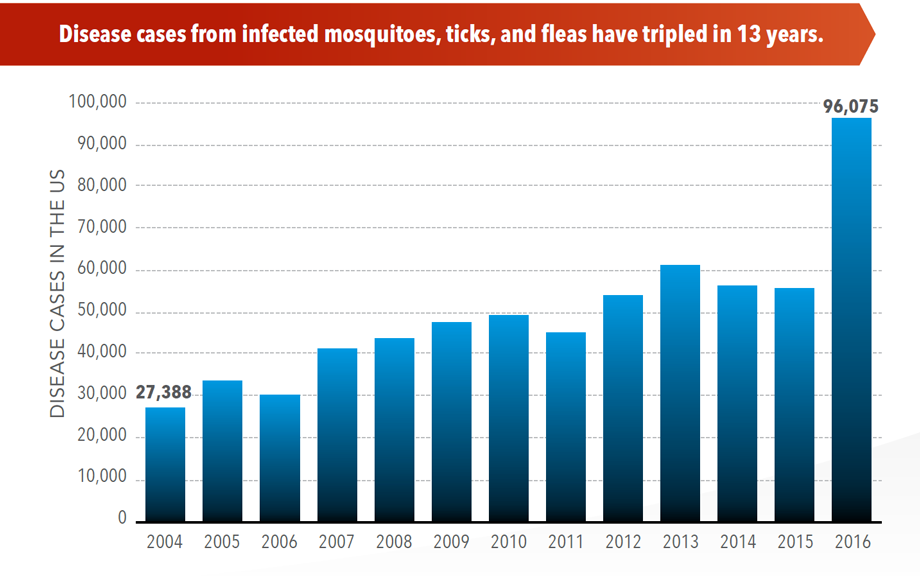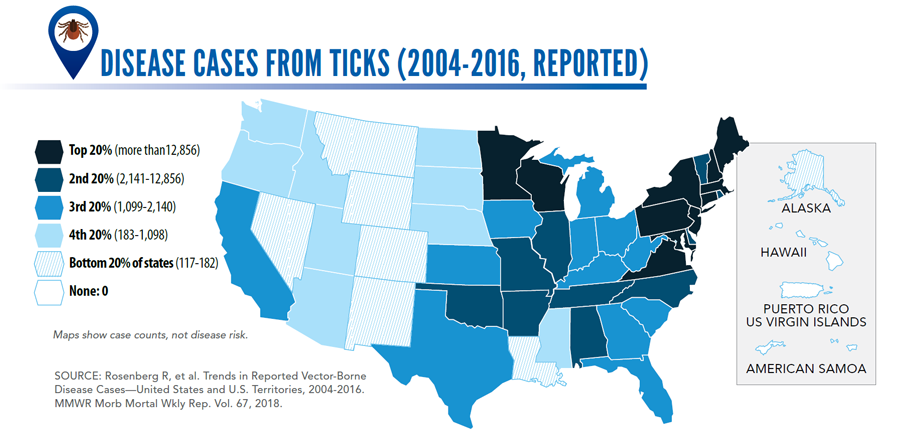Vital Signs: Illnesses on the rise
From mosquito, tick, and flea bites
3x. Disease cases from mosquito, tick, and flea bites tripled in the US from 2004 to 2016.
9. Nine new germs spread by mosquitoes and ticks have been discovered or introduced since 2004.
8 in 10. About 80% of vector control organizations lack critical prevention and control capacities.
Almost everyone has been bitten by a mosquito, tick, or flea. These can be vectors for spreading pathogens (germs). A person who gets bitten by a vector and gets sick has a vector-borne disease, like dengue, Zika, Lyme, or plague. Between 2004 and 2016, more than 640,000 cases of these diseases were reported, and 9 new germs spread by bites from infected mosquitoes and ticks were discovered or introduced in the US. State and local health departments and vector control organizations are the nation’s main defense against this increasing threat. Yet, 84% of local vector control organizations lack at least 1 of 5 core vector control competencies. Better control of mosquitoes and ticks is needed to protect people from these costly and deadly diseases.
State and local public health agencies can
- Build and sustain public health programs that test and track germs and the mosquitoes and ticks that spread them.
- Train vector control staff on 5 core competencies for conducting prevention and control activities. https://www.naccho.org/uploads/downloadable-resources/Mosquito-control-in-the-U.S.-Report.pdf
- Educate the public about how to prevent bites and control germs spread by mosquitoes, ticks, and fleas in their communities.

Increasing threat, limited capacity to respond
More cases in the US (2004-2016)
- The number of reported cases of disease from mosquito, tick, and flea bites has more than tripled.
- More than 640,000 cases of these diseases were reported from 2004 to 2016.
- Disease cases from ticks have doubled.
- Mosquito-borne disease epidemics happen more frequently.
More germs (2004-2016)
- Chikungunya and Zika viruses caused outbreaks in the US for the first time.
- Seven new tickborne germs can infect people in the US.
More people at risk
- Commerce moves mosquitoes, ticks, and fleas around the world.
- Infected travelers can introduce and spread germs across the world.
- Mosquitoes and ticks move germs into new areas of the US, causing more people to be at risk.
The US is not fully prepared
- Local and state health departments and vector control organizations face increasing demands to respond to these threats.
- More than 80% of vector control organizations report needing improvement in 1 or more of 5 core competencies, such as testing for pesticide resistance.
- More proven and publicly accepted mosquito and tick control methods are needed to prevent and control these diseases.
SOURCE: CDC Vital Signs, May, 2018
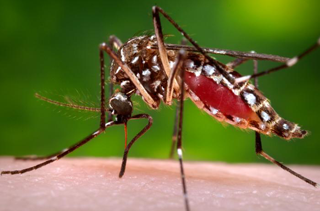
Mosquito-borne diseases
- California serogroup viruses
- Chikungunya virus
- Dengue viruses
- Eastern equine encephalitis virus
- Malaria plasmodium
- St. Louis encephalitis virus
- West Nile virus
- Yellow fever virus
- Zika virus
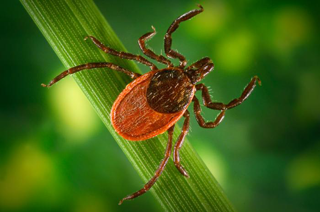
Tickborne diseases
- Anaplasmosis/ehrlichiosis
- Babesiosis
- Lyme disease
- Powassan virus
- Spotted fever rickettsiosis
- Tularemia
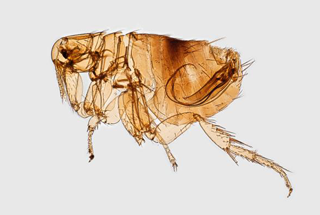
Fleaborne disease
- Plague
For more information: https://wwwn.cdc.gov/nndss/
Diseases from mosquito and tick bites occur in every state and territory.
Recent outbreaks of Zika, chikungunya, and West Nile viruses and the steady increase in Lyme disease cases point to the need for state and local agencies to have comprehensive vector-borne disease prevention and control programs. The US needs better tools and more staff with greater expertise at local and state levels to reduce the growing threat of these diseases in the US.
View large image and text description
View large image and text description
Controlling diseases from mosquitoes and ticks requires 5 core competencies.
Local health departments and vector control organizations must be able to:
- Monitor and track mosquitoes and ticks locally.
- Use data to drive local decisions about vector control.
- Have an action plan to kill mosquitoes and ticks at every life stage.
- Control vectors using multiple types of methods.
- Conduct pesticide-resistance testing.
SOURCE: NACCHO, http://bit.ly/2FG1OMw
The Federal government is
- Funding states, territories, industry, university, and international groups to detect and respond to infections from mosquitoes, ticks, and fleas and report cases to CDC. http://bit.ly/2GvmyDH
- Convening a Tick-Borne Disease Working Group established by the 21st Century Cures Act to improve federal coordination of tickborne disease efforts.
- Supporting 5 regional centers of excellence to address emerging diseases from mosquitoes and ticks. https://www.cdc.gov/vector
- Conducting and developing diagnostic tests, vaccines, and treatments for these diseases.
- Educating the public about protecting themselves from diseases resulting from an infective mosquito, tick, or flea bite. https://www.cdc.gov/vector
State and local government agencies can
- Build and sustain public health programs that test and track germs and the mosquitoes and ticks that spread them.
- Train vector control staff on 5 core competencies for conducting prevention and control activities. http://bit.ly/2FG1OMw
- Educate the public about how to prevent bites and control germs spread by mosquitoes, ticks, and fleas in their communities.
Universities and companies can
- Study mosquitoes and ticks to better understand how to control them.
- Develop new or better methods and products to kill mosquitoes and ticks at each stage of life.
- Discover or improve tests for diagnosing new and known diseases from infective mosquito and tick bites.
- Create and sustain information-sharing networks.
- Train the next generation of entomologists and vector control professionals.
Everyone can
- Use an Environmental Protection Agency-registered insect repellent. https://www.epa.gov/insect-repellents/find-repellent-right-you
- Wear long-sleeved shirts and long pants.
- Treat items, such as boots, pants, socks, and tents, with permethrin or buy permethrin-treated clothing and gear.
- Take steps to control ticks and fleas on pets.
- Find and remove ticks daily from family and pets. http://bit.ly/2nSlO3S
- Take steps to control mosquitoes, ticks, and fleas inside and outside your home. https://www.cdc.gov/zika/prevention/prevent-mosquito-bites.html http://bit.ly/2DbY6E3
Related Pages
- Morbidity and Mortality Weekly Report (MMWR): Vital Signs: Trends in Reported Vectorborne Disease Cases—United States and Territories, 2004–2016
- CDC’s Division of Vector-Borne Diseases:
Tickborne Diseases
- Public Health Grand Rounds: Emerging Tickborne Diseases
- Ticks
- Tickborne Diseases of the United States
- Prevent Tick Bites on People
- Prevent Tick Bites on Pets
- Prevent Ticks in the Yard
Mosquito-borne Diseases
Other Sites
- MedlinePlus – Mosquito Bites
- MedlinePlus – Tick Bites
- MedlinePlus – Insect Bites and Stings
- Mosquito Control Capabilities in the US: NACCHO Report


